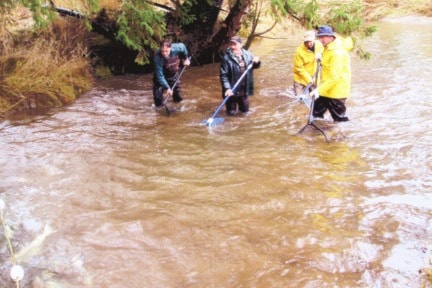Give your imagination a shot and try to visualize the salmon pyramid in Area 14. Think of the northern base at the Oyster River, the eastern base in the middle of Georgia Strait, the southern base below the Qualicum Rivers drainage, and the western base the Beaufort Mountains. My imaginary pyramid base is about 60km (40 miles) square along the base.
Pyramids are normally thought of as very stable structures. However, when we talk of living pyramids as in ecological systems, we tend to allow for fluctuations in the basic life supporting units that form the pyramid.
Last week my column concentrated on the significant returns we get from the major government hatcheries such as the Puntledge River and the Qualicum facilities. Another significant contributor to the well-being of the salmon pyramid in Area 14 is the crucially important role played by the volunteer enhancement groups and their salmon rearing facilities.
The Pacific Salmon Foundation, with its often repeated goal to bring the salmon resources back "one stream at a time," is a major source of funding for small groups who have the volunteer people power to do enhancement work, but need financial funding to
carry out their work on the ground and water objectives. There is also important funding from industrial groups, private fund foundations and local fundraising contributions.
There are many little salmon pyramids spread throughout our large pyramid that function as basic building blocks to the larger pyramid; each with varying populations of salmon. These small jewels of salmon habitat have been altered and degraded by us in our ongoing obsession with growth and development for people at the expense of other life forms. It is in the small systems that local enhancement groups make such an important contribution to the stability of the larger pyramid.
The past few weeks have been particularly busy for small enhancement associations as they frantically capture small numbers of returning salmon to collect their spawn for the enhancement of the their system. The work of the small societies really takes off after the sperm has fertilized the egg. As in all new life, the beginning is fraught with much danger and is extremely frail.
Let your imagination take you back to one of the spectacular scenes in any of the many movies of the pyramids in Egypt and you will have a vision of thousands of people toiling to build the bases of these great monuments.
Now let your mind return to the present and in your mind's eye recreate the visions of hundreds of volunteers wading up small streams during cold, wet weather as they collect adult salmon to supply eggs for their small hatcheries. Most of the people in the movies were depicted as slaves – and aside from food and shelter they worked for nothing. In the case of our enhancement volunteers they not only work for nothing, but they provide their own food and shelter and spend much time in raising rands to carry out their life building pyramids. I sometimes wonder how history will judge our civilization.
In the meantime, the small hatchery is now replenished with fertilized eggs that must be nurtured until they hatch. Following the birthing event the little salmon must be cared for until they are able to survive on their own in the broader environment of the natal stream.
The work does not end in the security of the hatchery. Just as we try to give our own species a supportive environment, the small enhancement associations spend much of the year making certain their little salmon have safe environments when they are released into the larger world. One small society has gone beyond the enhancement of their natal stream to enhancing the marine environment by re-growing kelp beds that are critical habitat for survival of small fish in the ocean.
Large life pyramids are built on the building blocks of smaller systems that support the larger structure. There are thousands of people who volunteer hundreds of thousands hours of free labour to enhance our coastal salmon systems. I wonder how history will judge their living monuments.
When you are asked to support salmon enhancement programs, maybe these are some of the reasons you might want to consider a positive response.
Ralph Shaw is a master fly fisherman who was awarded the Order of Canada in 1984 for his conservation efforts. In 20 years of writing a column in the Comox Valley Record it has won several awards.
